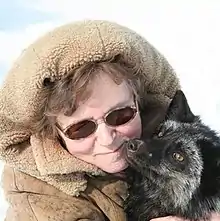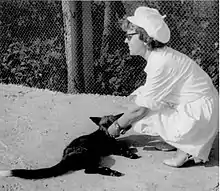Lyudmila Trut
Lyudmila Nikolayevna Trut (Russian: Людми́ла Никола́евна Трут, born 6 November 1933) is a Russian geneticist, ethologist, and evolutionist. She is known for developing domesticated silver foxes from wild foxes with Dmitry Belyayev at the Institute of Cytology and Genetics in Novosibirsk, Russia. The experiment, started in 1952, continues to this day covering nearly 60 generations of silver foxes selected for "tameness."[1] She has held the positions of Senior researcher for Evolutionary genetics, Institute of Cytology and Genetics SB AS USSR, from 1969 to 1985; Head of Laboratory for Evolutionary Genetics, Institute of Cytology and Genetics, USSR, 1985 to 1990; Main Scientific Employee in the Laboratory for Evolutionary Genetics, Institute of Cytology and Genetics SB AS USSR, 1990 until the present; and Professor in Genetics, 2003 to the present at the Institute of Cytology and Genetics.[2][3] Today she coordinates educational activities at the experimental fox farm at the Institute of Cytology and Genetics of the Russian Academy of Sciences in Novosibirsk, Russia. Trut was elected to the American Academy of Arts and Sciences in 2020.[4]
Lyudmila Nikolayevna Trut | |
|---|---|
 Lyudmila Trut with domesticated fox | |
| Born | Lyudmila Nikolayevna Trut 6 November 1933 Yuriev-Polskiy Regional Center, Vladimir Region, Soviet Union. |
| Awards | •Gold and Silver medals of the Exhibition of Economic Achievements of the USSR (Domesticated foxes) •Prize of the Presidium of the Academy of Sciences of the USSR named acad. N.I. Vavilov (1985) •The Order of the Badge of Honor (August 21, 1986) •Winner of 2018 The American Association for the Advancement of Science (AAAS)/Subaru Science Books & Film Prizes for Excellence in Science Books |
Education
Lyudmila grew up in the town of Kirzhach in Vladimir, Russia Region of the Soviet Union, now Russia. She went to elementary school there, as well as high school. She graduated with Honors at Moscow State University in 1958, majoring in Biology. In 1966 she earned a Candidate of Sciences Ph.D.; her Thesis was titled: "On correlation of behavior characteristics with reproductive function in fur bearing animals of the Canidae family" from the Institute of Cytology and Genetics in Novosibirsk. In 1981 she earned a Doctor of Sciences Ph.D.; her Thesis was titled: "The role of behavior in the transformation of silver foxes during domestication" also from the Institute of Cytology and Genetics in Novosibirsk.
Research

The domesticated silver fox is a form of the silver fox which has been domesticated - to some extent - under laboratory conditions. The silver fox is a melanistic form of the wild red fox. Domesticated silver foxes are the result of an experiment which was designed to demonstrate the power of selective breeding to transform species, as described by Charles Darwin in On the Origin of Species.[5] The experiment explored whether selection for behaviour rather than morphology may have been the process that had produced dogs from wolves, by recording the changes in foxes when in each generation only the most tame foxes were allowed to breed. Many of the descendant foxes became both tamer and more dog-like in morphology, including displaying mottled or spotted coloured fur.[6][7]
Today, the experiment is under the supervision of Lyudmila Trut.[8][9][7]
References
- Trut, Lyudmila; Dugatkin, Lee Alan (2017). "How to Build a Dog". Scientific American. 316 (5): 68–73. Bibcode:2017SciAm.316e..68T. doi:10.1038/scientificamerican0517-68. PMID 28437410.
- Browne, Malcolm (March 30, 1999). "New Breed of Fox as Tame as a Pussycat". New York Times.
- Dugatkin, L.A.; Trut, L.N. (2017). How to Tame a Fox (and Build a Dog): Visionary Scientists and a Siberian Tale of Jump-Started Evolution. Chicago: University of Chicago Press. p. 240.
- "New Members". American Academy of Arts & Sciences. Retrieved 2020-04-23.
- Darwin, Charles (1859). "1". On the Origin of Species by Means of Natural Selection, or the Preservation of Favoured Races in the Struggle for Life (1963 reprint ed.). Norwalk, Connecticut: Heritage Press. p. 470.
- Trut, Lyudmila (1999). "Early Canid Domestication: The Farm-Fox Experiment". American Scientist. 87 (2): 160. Bibcode:1999AmSci..87.....T. doi:10.1511/1999.2.160. JSTOR 27857815.
- Trut, Lyudmilla; Dugatkin, Lee Alan (23 March 2017). How to Tame a Fox (and Build a Dog): Visionary Scientists and a Siberian Tale of Jump-Started Evolution (1st ed.). Chicago: University Of Chicago Press. p. 240. ISBN 978-0226444185.
- "Domestication of foxes and problems of modern animal breeding". www.bionet.nsc.ru. Retrieved 5 July 2016.
- "Why domesticated foxes are genetically fascinating (and terrible pets)". pbs.org. 2017-03-31.